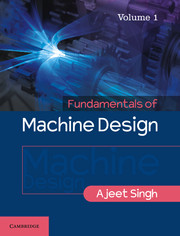2 - Engineering Materials
Published online by Cambridge University Press: 17 July 2025
Summary
Introduction
An engineer has to select a suitable material for a machine element to withstand the loads coming on it. A wrong selection may lead to its failure. It has to withstand not only the load, but should possess qualities depending upon many factors like toughness, hardness, life, stiffness, etc. There is a wide range of materials now available, from which a design engineer has to choose according to the requirement of a particular component that performs a specific function.
Material Properties
The selection of material depends upon strength requirement, permissible deflections, mass, life, type of service, working environment, reliability, cost, quantity required, availability, and material properties. The various material properties to be considered are tabulated alphabetically in Table 2.1. Table 2.2 gives physical properties of commonly used metals.
Classification of Engineering Materials
Engineering materials are broadly classified as metals and non metals. Metals are of two types: Ferrous and Non-ferrous
Amongst ferrous metals, wrought iron (WI) is the purest form of iron (Fe). A little percentage of carbon (C) increases its hardness. Steel up to 0.25 per cent carbon is called low carbon steel. Mild steel is the most commonly used and has carbon between 0.25–0.8 per cent. Items, like tools, etc., are made of high carbon steel with carbon between 0.8–1.5 per cent.
Metals having 2–3 per cent of carbon are called cast iron and those containing carbon between 3–4 per cent are called grey cast iron. Some alloying elements like copper (Cu), chromium (Cr), lead (Pb), magnesium (Mg), manganese (Mn), molybdenum (Mo), nickel (Ni), phosphorus (P), silicon (Si), and sulphur (S) are added to improve the properties of steels and such steels are called alloy steels.
Information
- Type
- Chapter
- Information
- Fundamentals of Machine Design , pp. 20 - 54Publisher: Cambridge University PressPrint publication year: 2017
